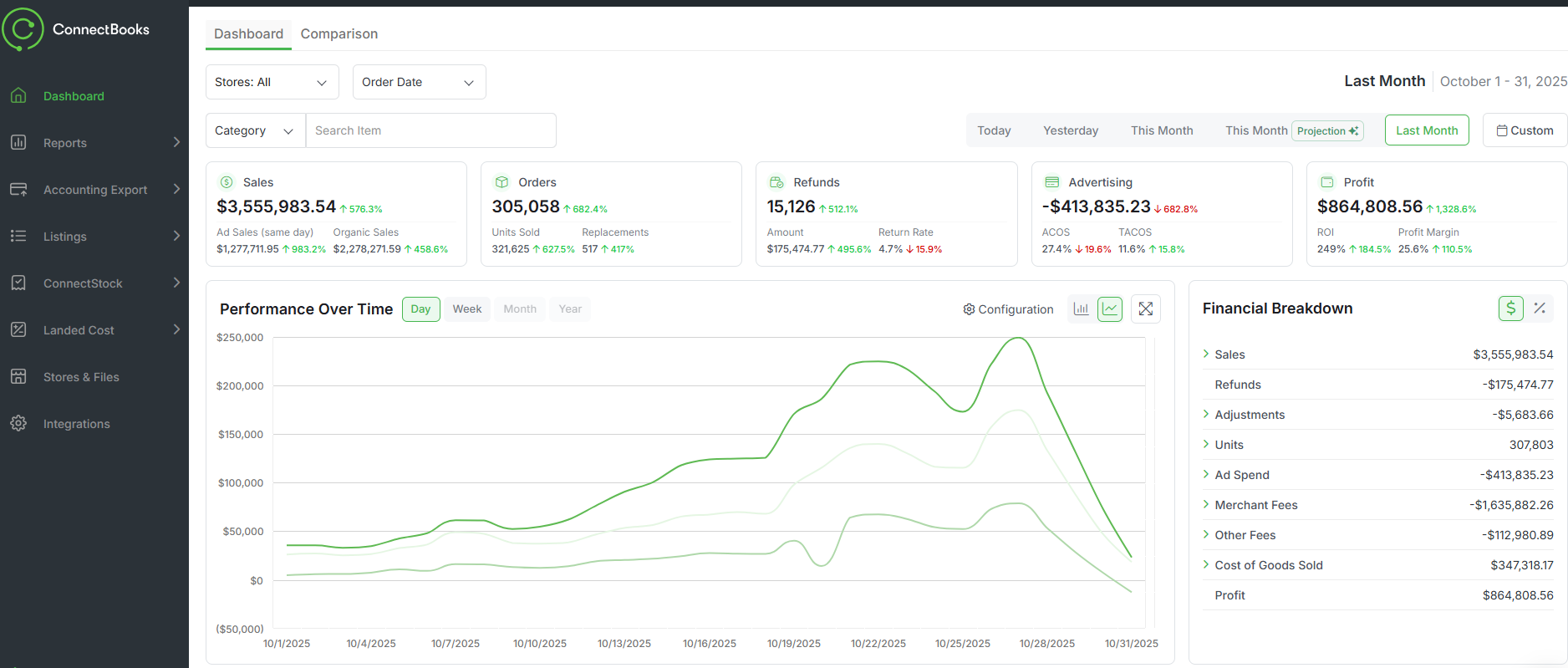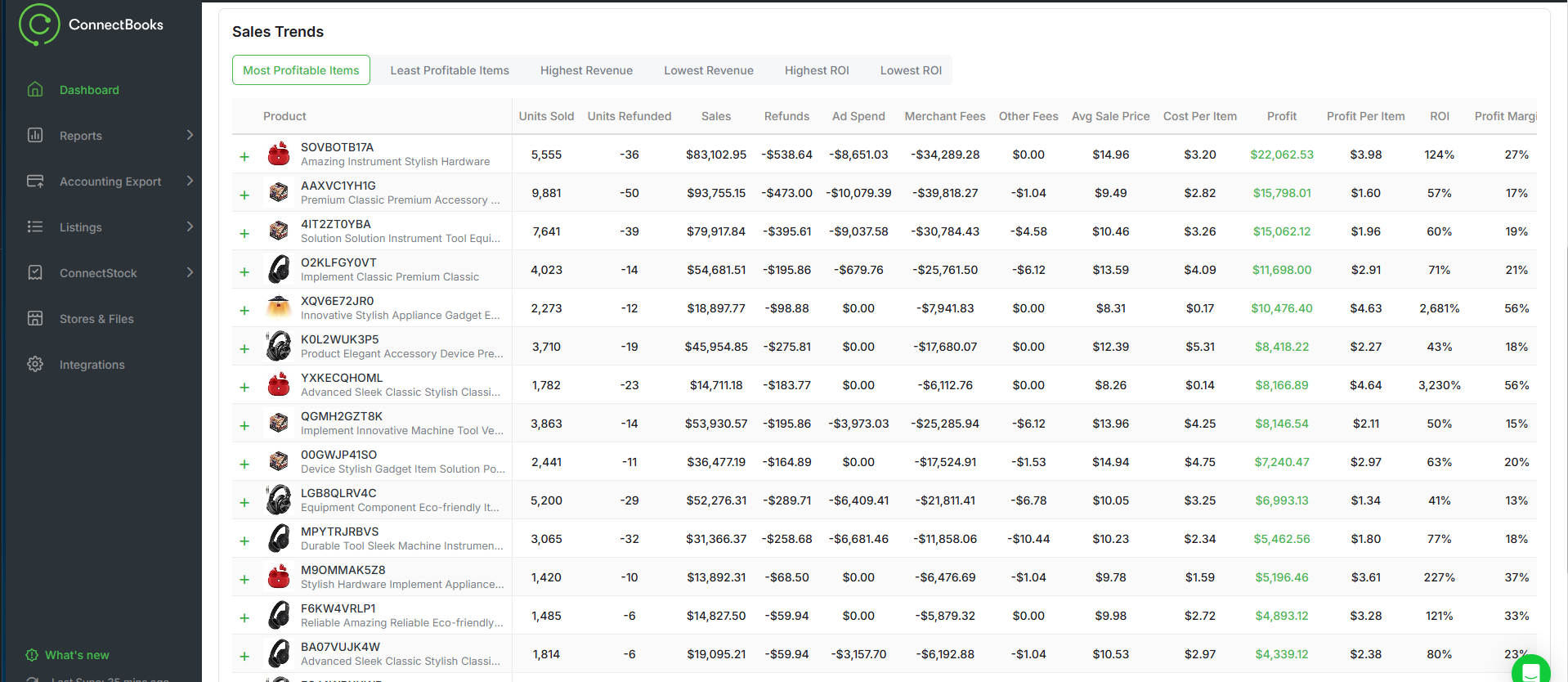Running an ecommerce business is a bit like operating a high-performance engine: everything looks smooth from the outside, but under the hood there are dozens of small moving parts that all have to work together. When even one of those parts slips out of alignment (an unnoticed fee increase, overspending on ads, SKU-level margin erosion), profits can disappear quietly.
Most sellers don’t lose money because of one big dramatic mistake. They lose money in the details.
And on Amazon, Shopify, TikTok Shop, Walmart, and beyond, those details add up fast.
That’s exactly why ConnectBooks exists: to help ecommerce brands and accountants regain total financial clarity, eliminate hidden leaks, and make smarter decisions with clean, real-time data. In this post, we’re digging into the five biggest places where sellers unintentionally bleed cash and how ConnectBooks helps seal those gaps for good.
Amazon fees aren’t inherently the villain — they’re the cost of doing business on the world’s largest marketplace. But the structure of those fees can be confusing, inconsistent, and easy to overlook.
Most sellers rely on Amazon reports that bundle fees into broad categories, making it nearly impossible to understand:
When you’re moving thousands of units per month, even a small discrepancy (a few cents here, a dollar there) can snowball into thousands of dollars lost.
ConnectBooks gives sellers a crystal-clear breakdown of every Amazon fee at the SKU level.
Instead of drowning in spreadsheets, you get:

This visibility empowers brands to spot margin drainers instantly and adjust pricing, strategy, or fulfillment before losses escalate.
One ConnectBooks customer put it perfectly:
“ConnectBooks showed us EXACTLY what we’re paying in Amazon fees and ad spend, so we instantly see which items are more profitable.”
That level of clarity isn’t just convenient — it’s money-saving.
Advertising is one of the biggest sources of wasted spend for ecommerce brands. PPC campaigns can look like they’re performing when they’re actually costing you more money than they return. Many sellers rely solely on ACoS or ROAS, which doesn’t always tell the full story.
Without tying ad spend directly to net profitability, you might be scaling campaigns that grow revenue… while shrinking margins.
ConnectBooks integrates advertising spend directly into your profitability calculations, automatically and in real time.
This means you can finally answer questions like:
Instead of guessing or toggling between disconnected dashboards, ConnectBooks provides unified clarity. You see instantly how each dollar of ad spend affects your actual profit, not just your sales numbers.
Once sellers see profitability after ad spend, their decisions become sharper, faster, and far more profitable.

A stunning number of ecommerce sellers operate without true SKU-level financials. They know overall revenue and overall profit, but have no idea which products are:
When product profitability isn’t clear, sellers unintentionally scale the wrong SKUs, sunset profitable items too soon, or invest in inventory that doesn’t perform.
ConnectBooks delivers complete SKU-level clarity that shows exactly:
Everything updates in real time and is tied to your accounting system with seamless integrations with QuickBooks and Xero, ensuring 100% accuracy and eliminating the guesswork.
This empowers sellers to:
It’s hard to optimize what you can’t see. ConnectBooks finally makes the invisible visible.

Ecommerce accounting is notoriously messy. Between multi-channel sales, inventory valuation, fee complexity, and ad spend allocation, it’s easy for books to become inaccurate — even for experienced accountants.
Manual reconciliation leads to:
When financials are wrong, every decision built on top of them is wrong too.
ConnectBooks automatically syncs marketplace data (Amazon, Shopify, TikTok, Walmart, etc.) with accounting software like QuickBooks and Xero — accurately and with the proper configuration.
This includes:
With ConnectBooks, accountants don’t have to guess. Everything is mapped, categorized, and posted correctly which reduces errors and saves many hours of manual work.
For brands, this means financials they can trust.
For accountants, it means efficiency, accuracy, and a lot fewer headaches.

One of the biggest threats to ecommerce cash flow isn’t poor sales. It’s inventory that sits too long. Aging inventory quietly locks up capital, inflates storage costs, hurts performance metrics, and limits your ability to reinvest in the products that actually drive growth.
When units move slowly through the warehouse or sit in FBA long enough to hit 180, 270, or 365-day thresholds, your cash becomes trapped in unsold stock. Not only do your long-term storage fees rise, but you also lose liquidity, face higher risk of liquidation or write-downs, and weaken your Inventory Performance Index.
For fast-moving ecommerce businesses, this is one of the most common (and costly!) blind spots. Sellers often don’t realize how much capital is tied up until it’s too late.
ConnectBooks gives you the visibility and insights you need to prevent aging inventory from choking your cash flow.
Here’s how:
Aging inventory is a silent cash-flow killer, but it doesn’t have to be. ConnectBooks gives you the tools to stay ahead of it, protect your capital, and keep your business agile — so your cash works for you instead of sitting on a shelf.

Ecommerce brands aren’t just fighting competitors — they’re fighting complexity. The biggest risk isn’t a new seller entering the market. It’s failing to see the details that drain profitability.
ConnectBooks eliminates that risk by giving you:
All in one place, fully automated, and built specifically for the realities of ecommerce.
When you stop losing money in the details, you gain the power to scale faster, operate more confidently, and protect your margins every step of the way.
Running an e-commerce business comes with plenty of challenges, but ConnectBooks is here to make your life easier. With real-time insights, seamless integrations, and detailed tracking of your profitability and inventory, you can stay ahead of the game. Whether you’re selling on Amazon, Shopify, Walmart, TikTok or eBay, ConnectBooks helps you manage your finances with 100% accuracy and confidence, so you can focus on growing your business.
Ready to level up? Start making smarter, data-driven decisions every step of the way. Try ConnectBooks Free Today or Schedule a Demo